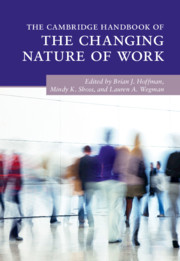Book contents
- The Cambridge Handbook of the Changing Nature of Work
- The Cambridge Handbook of the Changing Nature of Work
- Copyright page
- Contents
- Figures
- Tables
- Contributors
- Part I Introduction to the Changing Nature of Work
- Part II What Has Changed?
- Part III Implications for Talent Management and Impact on Employees
- 14 Implications of the Changing Nature of Work for Selection
- 15 Implications of the Changing Nature of Work for Recruitment and Retention
- 16 Performance Management and the Changing Nature of Work
- 17 Implications of the Changing Nature of Work for Training
- 18 Leader Behaviors and the Changing Nature of Work
- 19 The Changing Nature of Teams
- 20 Managing Employees across the Working Lifespan
- 21 Implications of the Changing Nature of Work for Employee Attitudes and Work Perceptions
- 22 Implications of the Changing Nature of Work for the Interface between Work and Nonwork Roles
- 23 Implications of the Changing Nature of Work for Employee Health and Safety
- 24 The Dark Side of Workplace Technology
- 25 Implications of the Changing Nature of Work for the Employee–Organization Relationship
- 26 The Future of Work
- 27 Sustainability as a Driver of Organizational Change
- Index
- References
26 - The Future of Work
from Part III - Implications for Talent Management and Impact on Employees
Published online by Cambridge University Press: 02 April 2020
- The Cambridge Handbook of the Changing Nature of Work
- The Cambridge Handbook of the Changing Nature of Work
- Copyright page
- Contents
- Figures
- Tables
- Contributors
- Part I Introduction to the Changing Nature of Work
- Part II What Has Changed?
- Part III Implications for Talent Management and Impact on Employees
- 14 Implications of the Changing Nature of Work for Selection
- 15 Implications of the Changing Nature of Work for Recruitment and Retention
- 16 Performance Management and the Changing Nature of Work
- 17 Implications of the Changing Nature of Work for Training
- 18 Leader Behaviors and the Changing Nature of Work
- 19 The Changing Nature of Teams
- 20 Managing Employees across the Working Lifespan
- 21 Implications of the Changing Nature of Work for Employee Attitudes and Work Perceptions
- 22 Implications of the Changing Nature of Work for the Interface between Work and Nonwork Roles
- 23 Implications of the Changing Nature of Work for Employee Health and Safety
- 24 The Dark Side of Workplace Technology
- 25 Implications of the Changing Nature of Work for the Employee–Organization Relationship
- 26 The Future of Work
- 27 Sustainability as a Driver of Organizational Change
- Index
- References
Summary
With technologies advancing at a rapid pace, research exploring the potential impact of technologies on work (see Frey & Osborne, 2013, 2017) sparked widespread interest in the topic. This chapter reviews the emerging future-of-work domain with a focus on research efforts and key trends. This includes an overview of key future-of-work concepts, a brief review of historical examples of technological job disruption concerns, an exploration of the technological forces driving current work changes, a review of studies exploring the potential for automation, and an overview of opportunities for understanding and shaping the future of work.
Keywords
Information
- Type
- Chapter
- Information
- The Cambridge Handbook of the Changing Nature of Work , pp. 555 - 582Publisher: Cambridge University PressPrint publication year: 2020
References
Accessibility standard: Unknown
Why this information is here
This section outlines the accessibility features of this content - including support for screen readers, full keyboard navigation and high-contrast display options. This may not be relevant for you.Accessibility Information
- 3
- Cited by
